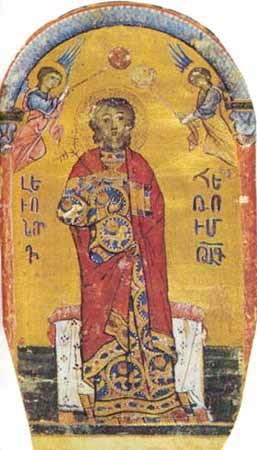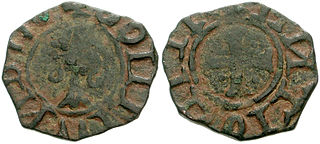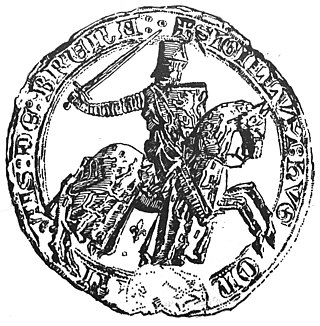Related Research Articles

The Principality of Antioch was one of the Crusader states created during the First Crusade which included parts of modern-day Turkey and Syria. The principality was much smaller than the County of Edessa or the Kingdom of Jerusalem. It extended around the northeastern edge of the Mediterranean, bordering the County of Tripoli to the south, Edessa to the east, and the Byzantine Empire or the Kingdom of Armenia to the northwest, depending on the date.

Hugh I succeeded to the throne of Cyprus on 1 April 1205 underage upon the death of his elderly father Aimery, King of Cyprus and Jerusalem. His mother was Eschiva of Ibelin, heiress of that branch of Ibelins who had held Bethsan and Ramleh.

Hethum I ruled the Armenian Kingdom of Cilicia from 1226 to 1270. He was the son of Constantine of Baberon and Princess Alix Pahlavouni of Lampron and was the founder of the dynasty which bears his name: the Hethumids also known as the House of Lampron. Having accepted the suzerainty of the Mongol Empire, Hethum himself traveled to the Mongol court in Karakorum, Mongolia, a famous account of which is given by Hethum's companion, the historian Kirakos Gandzaketsi, in his History of Armenia. He allied with the Mongols to fight against the Muslim Mamluks and also encouraged other Crusader states to do the same.

Leo II or Leon II was king of the Armenian Kingdom of Cilicia, ruling from 1269/1270 to 1289. He was the son of King Hetoum I and Queen Isabella and was a member of the House of Lampron.

Leo II was the tenth lord of Armenian Cilicia, ruling from 1187 to 1219, and the first king to be crowned, in 1198/9. During his reign, Leo succeeded in establishing Cilician Armenia as a powerful and unified Christian state with a pre-eminence in political affairs. Leo eagerly led his kingdom alongside the armies of the Third Crusade and provided the crusaders with provisions, guides, pack animals and all manner of aid. Under his rule, Armenian power in Cilicia was at its apogee: his kingdom extended from Isauria to the Amanus Mountains.
Ruben III, also Roupen III, Rupen III, or Reuben III, was the ninth lord of Armenian Cilicia (1175–1187).

Bohemond III of Antioch, also known as Bohemond the Child or the Stammerer, was Prince of Antioch from 1163 to 1201. He was the elder son of Constance of Antioch and her first husband, Raymond of Poitiers. Bohemond ascended to the throne after the Antiochene noblemen dethroned his mother with the assistance of the lord of Armenian Cilicia, Thoros II. He fell into captivity in the Battle of Harim in 1164, but the victorious Nur ad-Din, atabeg of Aleppo released him to avoid coming into conflict with the Byzantine Empire. Bohemond went to Constantinople to pay homage to Manuel I Komnenos, who persuaded him to install a Greek Orthodox patriarch in Antioch. The Latin patriarch of Antioch, Aimery of Limoges, placed Antioch under interdict. Bohemond restored Aimery only after the Greek patriarch died during an earthquake in 1170.

Bohemond IV of Antioch, also known as Bohemond the One-Eyed, was Count of Tripoli from 1187 to 1233, and Prince of Antioch from 1201 to 1216 and from 1219 to 1233. He was the younger son of Bohemond III of Antioch. The dying Raymond III of Tripoli offered his county to Bohemond's elder brother, Raymond, but their father sent Bohemond to Tripoli in late 1187. Saladin, the Ayyubid sultan of Egypt and Syria, conquered the county, save for the capital and two fortresses, in summer 1188.
Raymond-Roupen was a member of the House of Poitiers who claimed the thrones of the Principality of Antioch and Armenian Kingdom of Cilicia. His succession in Antioch was prevented by his paternal uncle Bohemond IV, but his maternal great-uncle Leo I of Cilicia recognized him as heir presumptive to Cilicia and pressed his claim to Antioch. In 1211 Raymond-Roupen was crowned junior king of Cilicia, and was finally installed as Prince of Antioch in 1216. The War of the Antiochene Succession ended with Leo's death in 1219, shortly before Raymond-Roupen was ousted from Antioch. He then pursued his claim to Cilicia, which Leo had unexpectedly willed to his daughter Isabella on his deathbed, but was defeated and imprisoned until death.

The Kingdom of Jerusalem, one of the Crusader states that was created in 1099, was divided into a number of smaller seigneuries. According to the 13th-century jurist John of Ibelin, the four highest crown vassals in the kingdom proper were the count of Jaffa and Ascalon, the prince of Galilee, the lord of Sidon, and the lord of Oultrejordain.

Isabella, also Isabel or Zabel, was queen regnant of Armenian Cilicia from 1219 until her death in 1252.

Hugh, Count of Brienne and Lecce was the second surviving son of Count Walter IV of Brienne and Marie de Lusignan of Cyprus.

The Ramnulfids, or the House of Poitiers, were a French dynasty of Frankish origin ruling the County of Poitou and Duchy of Aquitaine in the 9th through 12th centuries. Their power base shifted from Toulouse to Poitou. In the early 10th century, they contested the dominance of northern Aquitaine and the ducal title to the whole with the House of Auvergne. In 1032, they inherited the Duchy of Gascony, thus uniting it with Aquitaine. By the end of the 11th century, they were the dominant power in the southwestern third of France. The founder of the family was Ramnulf I, who became count in 835.

The Embriaco were a prominent Genoese family, who played an important role in the history of the Crusader states. It also gave consuls, admirals and ambassadors to the Republic of Genoa.
Mary of Lusignan, was the wife of Count Walter IV of Brienne and Countess of Brienne from the time of her marriage in 1233 to her husband's death while on Crusade in 1244. Mary's parents were King Hugh I of Cyprus and Alice of Champagne, making her a maternal granddaughter of Queen Isabella I of Jerusalem. Her two surviving sons were John, Count of Brienne, and Hugh of Brienne.
Alice of Armenia was ruling Lady of Toron from 1229 to 1234 as the eldest daughter of Ruben III, Prince of Armenia and his wife Isabella of Toron. She was heiress of Toron as well as a claimant to the throne of Armenia. She married three times; by her second marriage she was Countess of Tripoli, and she only had children from this marriage.
John Doukas Komnenos was a son of Andronikos Komnenos. Through his father, he was a grandson of Byzantine Emperor John II Komnenos. He was doux of Cyprus from 1155 until his death as well as being appointed a protovestiarios in 1148.

The War of the Antiochene Succession, also known as the Antiochene War of Succession, comprised a series of armed conflicts in northern Syria between 1201 and 1219, connected to the disputed succession of Bohemond III of Antioch. The Principality of Antioch was the leading Christian power in the region during the last decades of the 12th century, but Armenian Cilicia challenged its supremacy. The capture of an important fortress, Bagras, in Syria by Leo II of Cilicia gave rise to a prolonged conflict already in the early 1190s. Leo tried to capture Antioch, but the Greek and Latin burghers formed a commune and prevented the Armenian soldiers from occupying the town. Bohemond III's eldest son, Raymond, died in 1197, leaving an infant son, Raymond-Roupen. The boy's mother, Alice of Armenia, was Leo I's niece and heir presumptive. Bohemond III and the Antiochene noblemen confirmed Raymond-Roupen's right to succeed his grandfather in Antioch, but the commune preferred Bohemond III's younger son, Bohemond, Count of Tripoli.
The Lordship of Botrun was a fief around the small town of Botrun in the County of Tripoli. The crusaders occupied Botrun in 1104, then the lordship was formed in 1115, until it was seized by the Mamluks of Qalawun in 1289.
William of Botron was Lord of Botron (1244–1262) in the County of Tripoli, and Constable of Jerusalem (1258–1262).